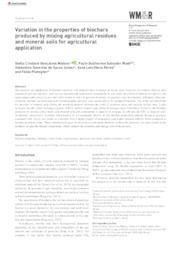Variation in the properties of biochars produced by mixing agricultural residues and mineral soils for agricultural application.
Variation in the properties of biochars produced by mixing agricultural residues and mineral soils for agricultural application.
Author(s): MATOSO, S. C. G.; WADT, P. G. S.; SOUZA JÚNIOR, V. S. de S.; PÉREZ, X. L. O.
Summary: The research and application of biochars enriched with minerals have increased in recent years; however, the mineral fraction used consists of specific minerals, such as clay minerals and synthesized compounds. In this work, the effects of adding two specific soil types (sandy and clayey) to rice and coffee husks in order to generate biochars via pyrolysis was investigated. Chemical, physical?chemical, thermal, spectroscopic and crystallographic analyses were conducted on the produced biochars. The study confirmed that the presence of mineral soils during the pyrolysis process increases the yield, C retention ratio, and specific surface area. It also decreases the pH, cation exchange capacity (CEC), nutrient content, and carbon-to-nitrogen ratio of biochars. However, the biochars produced by mixing coffee husks and mineral soils still demonstrate a capacity to increase the pH and the CEC of tropical soils. In addition, increased C retention demonstrates an environmental benefit of this biochar production method. Biomass pyrolysis combined with clayey soil results in a biochar with a higher degree of aromaticity and higher thermal stability when compared to biomass pyrolysis alone. These characteristics give the biochar a recalcitrant character, without the necessity for steps related to the synthesis of specific mineral compounds, which reduces the economic and energy cost of the process.
Publication year: 2020
Types of publication: Journal article
Unit: Embrapa Rondônia
Keywords: Biocarvão, Biochar, Biomass, Biomassa, Casca de Arroz, Casca de Café, Coffee husk, Corretivo, Crop residues, Pirólise, Pyrolysis, Resíduo Agrícola, Rice husk, Soil amendments, Solo
Observation
Some of Embrapa's publications are published as ePub files. To read them, use or download one of the following free software options to your computer or mobile device. Android: Google Play Books; IOS: iBooks; Windows and Linux: Calibre.
Access other publications
Access the Agricultural Research Database (BDPA) to consult Embrapa's full library collection and records.
Visit Embrapa Bookstore to purchase books and other publications sold by Embrapa.

